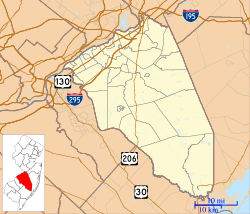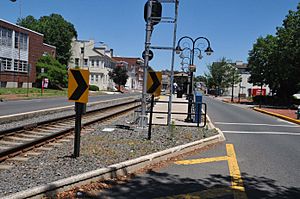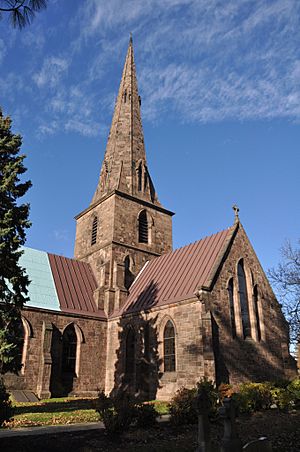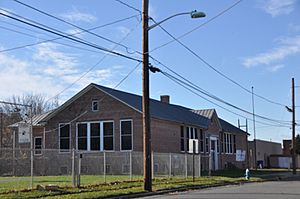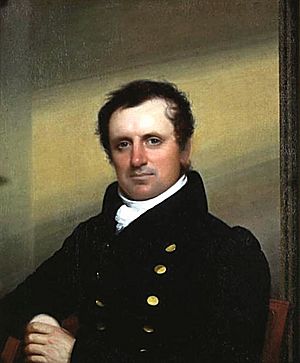Burlington, New Jersey facts for kids
Quick facts for kids
Burlington, New Jersey
|
|
|---|---|
|
City
|
|
| City of Burlington | |
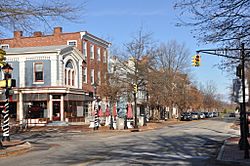
The High Street Historic District in Burlington
|
|

The City of Burlington highlighted in Burlington County. Inset map: Burlington County highlighted in the State of New Jersey.
|
|
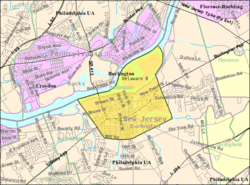
Census Bureau map of Burlington, New Jersey
|
|
| Country | |
| State | |
| County | |
| Formed | October 24, 1693 |
| Royal charter | May 7, 1733 |
| Incorporated | December 21, 1784 |
| Reincorporated | March 14, 1851 |
| Named for | Bridlington, England |
| Government | |
| • Type | Faulkner Act (mayor–council) |
| • Body | City Council |
| Area | |
| • Total | 3.78 sq mi (9.79 km2) |
| • Land | 3.06 sq mi (7.93 km2) |
| • Water | 0.72 sq mi (1.87 km2) 19.05% |
| Area rank | 306th of 565 in state 28th of 40 in county |
| Elevation | 10 ft (3 m) |
| Population | |
| • Total | 9,920 |
| • Estimate
(2019)
|
9,858 |
| • Rank | 245th of 566 in state 15th of 40 in county |
| • Density | 3,239.1/sq mi (1,250.6/km2) |
| • Density rank | 204th of 566 in state 10th of 40 in county |
| Time zone | UTC−05:00 (Eastern (EST)) |
| • Summer (DST) | UTC−04:00 (Eastern (EDT)) |
| ZIP Code |
08016
|
| Area code(s) | 609 |
| FIPS code | 3400508920 |
| GNIS feature ID | 0885174 |
Burlington is a city in Burlington County, New Jersey, United States and a suburb of Philadelphia. As of the 2010 United States Census, the city's population was 9,920, reflecting an increase of 184 (+1.9%) from the 9,736 counted in the 2000 Census, which had in turn declined by 99 (−1.0%) from the 9,835 counted in the 1990 Census.
Burlington was first incorporated on October 24, 1693, and was reincorporated by Royal charter on May 7, 1733. After American independence, the city was incorporated by the State of New Jersey on December 21, 1784. On March 14, 1851, the city was reincorporated and enlarged with portions of the surrounding township.
Burlington was originally the county seat of Burlington County. In 1796, in response to the growth of population to the east away from the Delaware River, the county seat was moved to Mount Holly Township, a more central location.
Contents
History
The council of West Jersey Proprietors purchased roughly 30 miles (48 km) of riverfront land in 1676 from the Lenape Native Americans. Burlington was founded on part of that land by English settlers (primarily Quakers) in 1677, and served as the capital of the province until 1702, when West Jersey and East Jersey were combined into a single Crown Colony.
Burlington takes its name (including the county name) from the English east-coast town of Bridlington, of which Burlington was a district. It is now amalgamated into the larger Bridlington town.
The Quakers formally established their congregation in 1678. Initially, they met in private homes; between 1683 and 1687, Francis Collings constructed a hexagonal meeting house of brick. Over the next century, the membership grew substantially and a larger building was needed. The present meeting house on High Street was built in 1783 in front of the old meeting house and cemetery. The cemetery predated the first building. A tablet commemorates that the Lenape chief King Ockanickon, a loyal friend of the English settlers, was buried here in 1681. The oldest gravestone is inscribed "D.B. 1726." Many notable Quakers are buried here.
One of the oldest buildings in Burlington is known as the Revell House. Originally built in 1685 for George Hutchinson, it stood on East Pearl Street. The property was soon purchased by Thomas Revell, one of the original European settlers. Local tradition associates this house with the young Benjamin Franklin, who received gingerbread while traveling from Boston to Philadelphia. In the early 20th century, the house was purchased by the Annis Stockton Chapter of the DAR to become their clubhouse. The Colonial Burlington Foundation acquired and restored it in the 1950s.
18th century
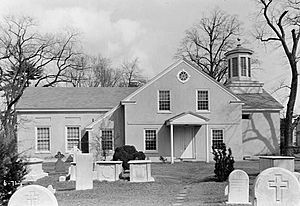
Many institutions established in the 18th century continue to function in the 21st century. After the Quakers, the second oldest religious congregation in Burlington were the Episcopalians. Their original church, Old St. Mary's, remains the oldest church in Burlington and New Jersey. The congregation was founded in 1702 by George Keith and John Talbot. Talbot became the first minister and laid the cornerstone for the church in 1703. He served as the church's rector until 1725. The congregation prospered, and the church became the see of the Anglican bishops of New Jersey. In 1846, under the leadership of Bishop and Rector George Washington Doane, construction was begun on New St. Mary's. This early Gothic Revival architecture church was designed by Richard Upjohn, who also designed Trinity Church at the foot of Wall Street in Lower Manhattan.
The Library Company of Burlington was organized in 1757 as a "free" library open to the public as well as members. There were 60 members of the original Library Company each paying ten shillings per year to support the institution. The Library received a Charter from King George II of Great Britain in 1758. The Library's books were kept in members' homes for a few years—Thomas Rodman's at 446 South High Street and, after 1767, Robert Smith's at 218 High Street. In 1789 the Library moved to its own building. The Library is currently in a stone building that was built on West Union Street in 1864. The Burlington Library is the oldest continuously operating library in New Jersey and the nation's seventh oldest.
The Endeavor Fire Company was organized in 1795 and was one of the four companies in the Burlington Fire Department when it was organized almost a century later. Endeavor was the first permanent firefighting organization in Burlington and remains one of the oldest fire companies under its original name in the state. By 1882, the Company had relocated to its present building, which was erected in 1852 as a Market House.
Burlington has been the home of many notable people including John Lawrence, a politician and his son, Captain James Lawrence. The elder Lawrence served in the State Assembly, as Mayor of Burlington, New Jersey in 1769, and as a member of the Provincial Council from 1771 to 1775. Unfortunately, he was suspected of being loyal to the British during the Revolution, which ended his career. His son was born on October 1, 1781 and became a legend during the War of 1812 with the command "Don't Give Up the Ship." Lawyer and writer, James Fenimore Cooper, who wrote The Last of the Mohicans, was also from Burlington.
19th century
The building at 301 High Street houses the oldest continuously operating pharmacy in New Jersey. Originally a dwelling, the ground floor was converted to commercial use around 1845 by William Allinson, a druggist, local historian, and leading Quaker abolitionist. He used the building as a center of anti-slavery activity. John Greenleaf Whittier denounced slavery from the doorstep, and local tradition holds that fugitive slaves hid in tunnels under the building.
During the 19th century, Burlington City was known for the quality and quantity of its manufacturing. The shoe industry rivaled shipbuilding and canning in prominence. The 1850 United States Census indicates that the largest number of men were employed in the shoe industry, followed closely by carpentry and bricklaying. J. Frank Budd got his start in the shoe business at a Burlington shoe company just after the Civil War. In 1887, J.F. Budd broke ground for a children's "shoeworks" at the corner of Penn and Dilwyn Streets. The company employed approximately 325 people and operated six days a week for ten hours a day. The J.F. Budd Baby Shoe Company billed itself as the "largest baby shoe plant in the world."
The commercial activity provided revenues for the City's cultural activity. In 1839, a Lyceum was erected as a venue for lectures, concerts, and public meetings. It served in that capacity until 1851, when it was turned over to the city to become City Hall. The municipal offices' move was concurrent with the adoption of a new City charter. The Oneida Boat Club was organized in 1873 by a group of 10 members. Over the next few years, the club grew rapidly and in 1876, they dedicated their newly built clubhouse on the banks of the Delaware River at York Street. The Oneida is the oldest continuously operating boat club on the Delaware River.
During this century, the City of Burlington grew in a grid pattern from the main crossroads of High and Broad Streets. Blocks of attached rowhouses built in the latest architectural style characterize the city as a 19th-century town.
20th century
Burlington's waterfront park was developed as a result of urban renewal and flood control projects in the late 1960s and 1970s. The shoreline improvements—revetments, walkways, etc.—span the city's Delaware riverfront from the Burlington-Bristol Bridge to Assiscunk Creek. The remains of former waterfront industries, ferry terminals and docks were demolished. Development of an open, grassy park with a tree-lined waterfront esplanade has reconnected the city to its riverfront for recreation. This ensures that business properties are not at risk during floods and reduces damages.
The Oneida Clubhouse narrowly escaped demolition during the urban renewal campaign. It was saved and renovated. As the new esplanade was built on fill that added land between the building and river's edge, it created a landlocked clubhouse for the boat club.
Burlington Coat Factory was founded in 1924 as a wholesaler of ladies' coats and outerwear. The modern company was formed in 1972 when Monroe Milstein purchased a warehouse in the outskirts of the city of Burlington, and started selling coats and outerwear. The company gradually added other apparel, including suits, shoes, and accessories, and has branched out to include baby items and linens, all at discount prices. The original Burlington Coat Factory relocated to a new store in the fall of 2008. The company's corporate headquarters was moved to Burlington Township in 1988.
Geography
According to the United States Census Bureau, the city had a total area of 3.782 square miles (9.793 km2), including 3.063 square miles (7.932 km2) of land and 0.719 square miles (1.861 km2) of water (19.00%).
Unincorporated communities, localities and place names located partially or completely within the city include Burlington Island and East Burlington.
Burlington borders Burlington Township in Burlington County and both Bristol and Bristol Township across the Delaware River in Pennsylvania. The Burlington-Bristol Bridge crosses the Delaware River, connecting Burlington to Bristol.
Demographics
| Historical population | |||
|---|---|---|---|
| Census | Pop. | %± | |
| 1850 | 4,536 | — | |
| 1860 | 5,174 | 14.1% | |
| 1870 | 5,817 | 12.4% | |
| 1880 | 6,090 | 4.7% | |
| 1890 | 7,264 | 19.3% | |
| 1900 | 7,392 | 1.8% | |
| 1910 | 8,336 | 12.8% | |
| 1920 | 9,049 | 8.6% | |
| 1930 | 10,844 | 19.8% | |
| 1940 | 10,905 | 0.6% | |
| 1950 | 12,051 | 10.5% | |
| 1960 | 12,687 | 5.3% | |
| 1970 | 12,010 | −5.3% | |
| 1980 | 10,246 | −14.7% | |
| 1990 | 9,835 | −4.0% | |
| 2000 | 9,736 | −1.0% | |
| 2010 | 9,920 | 1.9% | |
| 2019 (est.) | 9,858 | −0.6% | |
| Population sources: 1850–2000 1850–1920 1850–1890 1850–1870 1850 1870 1880–1890 1890–1910 1850–1930 1930–1990 2000 2010 |
|||
2010 Census
As of the census of 2010, there were 9,920 people, 3,858 households, and 2,438 families residing in the city. The population density was 3,239.1 per square mile (1,250.6/km2). There were 4,223 housing units at an average density of 1,378.9 per square mile (532.4/km2)*. The racial makeup of the city was 58.92% (5,845) White, 32.98% (3,272) Black or African American, 0.18% (18) Native American, 2.03% (201) Asian, 0.04% (4) Pacific Islander, 2.29% (227) from other races, and 3.56% (353) from two or more races. [[Hispanic (U.S. Census)|Hispanic or Latino of any race were 6.50% (645) of the population.
There were 3,858 households out of which 27.3% had children under the age of 18 living with them, 37.6% were married couples living together, 20.0% had a female householder with no husband present, and 36.8% were non-families. 30.8% of all households were made up of individuals, and 13.9% had someone living alone who was 65 years of age or older. The average household size was 2.53 and the average family size was 3.18.
In the city, the population was spread out with 23.9% under the age of 18, 8.6% from 18 to 24, 25.5% from 25 to 44, 26.4 % from 45 to 64, and 15.7% who were 65 years of age or older. The median age was 38.9 years. For every 100 females there were 87.7 males. For every 100 females ages 18 and old there were 83.8 males.
The Census Bureau's 2006–2010 American Community Survey showed that (in 2010 inflation-adjusted dollars) median household income was $48,317 (with a margin of error of +/− $3,334) and the median family income was $62,049 (+/− $6,446). Males had a median income of $43,146 (+/− $7,469) versus $40,929 (+/− $3,562) for females. The per capita income for the borough was $24,612 (+/− $1,541). About 10.6% of families and 11.8% of the population were below the poverty line, including 13.0% of those under age 18 and 7.4% of those age 65 or over.
Transportation
Roads and highways
As of May 2010[update], the city had a total of 42.76 miles (68.82 km) of roadways, of which 35.71 miles (57.47 km) were maintained by the municipality, 4.36 miles (7.02 km) by Burlington County, 2.30 miles (3.70 km) by the New Jersey Department of Transportation, and 0.39 miles (0.63 km) by the Burlington County Bridge Commission.
Main roads directly serving Burlington include U.S. Route 130, New Jersey Route 413, County Route 541 and County Route 543. Interstate 95, Interstate 295 and the New Jersey Turnpike all pass fairly close to the city and are easily accessible from Burlington.
The Burlington-Bristol Bridge, part of Route 413, crosses the Delaware River, connecting Burlington to Bristol Township, Pennsylvania, and is operated by the Burlington County Bridge Commission. Construction of the bridge started on April 1, 1930, and the bridge opened to traffic on May 1, 1931. The bridge carries NJ 413 and Pennsylvania Route 413.
Public transportation
NJ Transit provides bus service in the city between Trenton and Philadelphia on the 409 and 418 routes and between Burlington and Camden on the 413 and 419 routes.
The NJ River Line light rail system provides transportation between the Trenton Transit Center in Trenton and the Walter Rand Transportation Center (and other stations) in Camden, with stops at Burlington South and Burlington Towne Centre.
Points of interest
- Burlington Island, an island in the Delaware River between Burlington and Bristol, Pennsylvania. Plans were announced in 2012 to create an historic amusement park on the site.
- Doane Academy
- Elias Boudinot House – located at 207 W. Broad Street.
- James Lawrence House – located at 459 High Street and constructed in 1742, it was the home of the hero of the War of 1812, whose dying command has been paraphrased as "Don't give up the ship!".
- James Fenimore Cooper House
- Library Company of Burlington
- Odd Fellows Cemetery, at 4527 Route 130 South
- Old City Hall
- Quaker Meeting House
- Revell House
- St. Mary's Episcopal Church – the congregation's original church was constructed in 1703 and a new church building was added in 1854. The church's new building was added to the National Register of Historic Places in 1972 and was declared a National Historic Landmark in 1986.
- Waterfront Park and Oneida Boat Clubhouse – located at York Street on the Delaware riverfront, the club is the oldest continuously operated club on the river.
Education
The City of Burlington Public School District serves students in pre-kindergarten through twelfth grade. The district is one of 31 former Abbott districts statewide that were established pursuant to the decision by the New Jersey Supreme Court in Abbott v. Burke which are now referred to as "SDA Districts" based on the requirement for the state to cover all costs for school building and renovation projects in these districts under the supervision of the New Jersey Schools Development Authority. As of the 2020–21 school year, the district, comprised of four schools, had an enrollment of 1,740 students and 170.9 classroom teachers (on an FTE basis), for a student–teacher ratio of 10.2:1. The schools in the district (with 2020–21 enrollment data from the National Center for Education Statistics) are Captain James Lawrence Elementary School with 238 students in grades PreK-2, Samuel Smith Elementary School with 281 students in grades PreK-2, Wilbur Watts Intermediate School with 444 students in grades 3-6 and Burlington City High School with 727 students in grades 7-12. In 2018, the district closed Elias Boudinot Elementary School, which had served grades K-2, citing declining enrollment, the opportunities to reduce costs and the potential to raise funds by selling the site. The district's high school serves as a receiving school for students in grade nine through twelve from Edgewater Park Township, as part of a sending/receiving relationship with the Edgewater Park School District.
Students from Burlington City, and from all of Burlington County, are eligible to attend the Burlington County Institute of Technology, a countywide public school district that serves the vocational and technical education needs of students at the high school and post-secondary level at its campuses in Medford and Westampton Township.
Doane Academy, a co-educational, Episcopal college-preparatory school, was founded as St. Mary's Hall, a boarding school for girls, by George Washington Doane in 1837. The name was shortened from St. Mary's Hall-Doane Academy in March 2008. All Saints Catholic Grade School (Pre-K though 8th grade) closed in June 2006 with several other Catholic schools in the Roman Catholic Diocese of Trenton due to low enrollment, after 75 years of operation, based on recommendations issued in 2005 to help improve diocese finances.
Notable people
People who were born in, residents of, or otherwise closely associated with Burlington include:
- Eric Alejandro (born 1986), athlete representing Puerto Rico who competes mostly in the 400 meters hurdles.
- Eddie Blair (1871–1913), football player / coach and physician, who was an early professional football player with the Latrobe Athletic Association.
- Joseph Bloomfield (1753–1823), captain in Revolutionary War, New Jersey Attorney General, Chief Justice of the New Jersey Vice-Admiralty Court, president of the first Society for the Abolition of Slavery, Mayor from 1795 to 1800, Governor of New Jersey (1801–1802 and 1803–1812), a brigadier general in the War of 1812 and U.S. Representative from 1817 to 1821.
- Elias Boudinot (1740–1821), President of the Continental Congress from 1782 to 1783.
- William Bradford (1755–1795), fought in the American Revolution and became attorney general and justice of the Pennsylvania Supreme Court.
- D'Lo Brown (born 1970), WWE Wrestler.
- Cyrus Bustill (1732–1806), African-American brewer and baker, abolitionist and community leader.
- Isaac Collins (1746–1817), King's Printer who printed colonial currency, almanacs and a quarto Bible far more error-free than most of its contemporary editions.
- James Fenimore Cooper (1789–1851), novelist.
- William Coxe Jr. (1762–1831), early pomologist who was a U.S. Representative from New Jersey from 1813 to 1815.
- Oliver Cromwell (1752–1853), African-American soldier, who served with the 2nd New Jersey Regiment of the Continental Army during the American Revolutionary War.
- George Washington Doane (1799–1859) established St. Mary's Hall and Burlington College.
- Franklin D'Olier (1877–1953), first national commander of the American Legion.
- Howard Eastwood (1884–1976), Justice of the New Jersey Supreme Court from 1946 to 1948.
- Jehu Eyre (1738-1781), figure of the American Revolution
- Margaret Ellen Fox (born 1960), missing person who disappeared in the area, and whose case is still open.
- William Franklin (1731–1813), estranged son of Benjamin Franklin and last colonial governor of New Jersey.
- Ulysses S. Grant (1822–1885), Union Army general and the eighteenth President of the United States (1869–1877).
- Danny Green (1876–1914), early Major League Baseball outfielder who played for both Chicago baseball teams.
- William Griffith (1766–1826), judge who served on the United States circuit court and was Mayor from 1824 to 1826.
- Edward Burd Grubb Jr. (1841–1913), Civil War General and later United States Ambassador to Spain.
- Edward Burd Grubb Sr. (1810–1867), ironmaster.
- Ann Wood Henry (1734–1799), wife of William Henry, a gunsmith, inventor, and patriot in the American Revolution.
- Vanessa Kara (born 1996), professional soccer player who plays as a forward for National Women's Soccer League club Racing Louisville.
- James Kinsey (1731–1803), lawyer who served in the Continental Congress and as Chief Justice of the New Jersey Supreme Court.
- Dennis Landolt (born 1986), offensive tackle who has played in the NFL with the New York Jets.
- James Lawrence (1781–1813), War of 1812 naval officer.
- Joseph McIlvaine (1769–1826), United States Senator from New Jersey from 1823 until his death.
- George Middleton (1800–1888), represented New Jersey's 2nd congressional district from 1863 to 1865.
- Eddie Miksis (1926–2005), second baseman / outfielder who played for 14 seasons in Major League Baseball.
- Alex Pitko (1914–2011), outfielder who played for two seasons in Major League Baseball.
- John H. Pugh (1827–1905), represented New Jersey's 2nd congressional district in the United States House of Representatives from 1877 to 1879.
- Bowes Reed (1740–1794), lieutenant colonel in the New Jersey Militia who served as mayor of Burlington.
- William R. Rockhill (1793–1865), represented Indiana's 10th congressional district in the United States House of Representatives from 1847 to 1849.
- Maria Rodriguez-Gregg (born 1981), elected in 2013 as the first Republican Hispanic woman to be elected to the New Jersey Legislature.
- John Skene (died 1690), Deputy Governor of West Jersey who was the first Freemason in North America.
- Richard Smith (1735–1803), member of the Continental Congress from 1774 to 1776.
- Rod Streater (born 1988), NFL wide receiver for the Oakland Raiders.
- Anthony Taylor (1837–1894), awarded the Medal of Honor for his actions during the Civil War.
See also
 In Spanish: Burlington (Nueva Jersey) para niños
In Spanish: Burlington (Nueva Jersey) para niños


